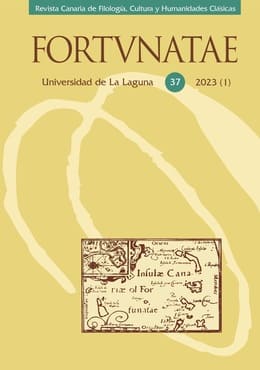La ékphrasis como género retórico-discursivo en la Gigantomachia de C. Claudiano
Resumen
Claudio Claudiano —probablemente de Alejandría— se instaló en Milán hacia finales del 395 d.C. en la corte imperial de Honorio, buscando desarrollar sus habilidades poéticas. Entre los autores del canon literario romano que gozan de biculturalidad lingüística, Claudiano es de los pocos que cuenta con versos en latín y griego. La Gigantomachia, escrita en ambas lenguas, expone las características contextuales de producción, puesto que exhibe técnicas retóricas propias de la Segunda Sofística. Durante la expansión de este fenómeno cultural, se intensificó el empleo de diferentes recursos estilísticos como la ékphrasis, que se advierte en la épica panegírica del poeta egipcio. Ante lo dicho, el presente trabajo se centrará en el análisis de la ékphrasis en la Gigantomachia latina, no como mero ornamento sino como una figura retórica que estructura los distintos momentos del relato, contribuyendo emocionalmente a la representación vívida de las imágenes según los principios de la retórica epidíctica. La importancia de la ékphrasis en la evolución de la epopeya tardía permite concebirla como un género donde la voz poética suspende el relato para desviar la atención del todo hacia la brillantez de sus partes, entrelazando las diferentes escenas bélicas por medio de variadas ekphráseis.
Citas
BARTSCH, S. - ELSNER, J. (2007): «Introduction: Eight Ways of Looking at an Ekphrasis», Classical Philology 102 (1): i-vi, Special Issues on Ekphrasis.
CAMERON, A. (1970): Claudian. Poetry and Propaganda at the Court of Honorius, Clarendon Press, Oxford.
CAMERON, A. (2011): The Last Pagans of Rome, Oxford University Press, Oxford.
CASON, F. (2017-2018): Claudiano, Gigantomachis (c.m. 53). Introduzione e commento, Università Ca’ Foscari, Venezia.
CASTALDO, D. (2013): «De flores despojando el verde llano». Claudiano nella poesía barocca, da Faría a Góngora, Università degli Studi di Napoli Federico II, Napoli.
CASTILLO BEJARANO, M. (1993): Claudiano. Poemas I-II, Gredos, Madrid.
CHARLET, J.-L. (2018): «Rivaliser avec Ovide (presque) sans Ovide: à propos de Claudien, Gigantomachie (carm. min. 53), vv. 91-113», en F. E. CONSOLINO (ed.), Ovid in Late Antiquity, Brepols, Tournhout, pp. 165-178.
CHRISTIANSEN, P. (1997): «Claudian: A Greek or a Latin?», Scholia 6: 79-95.
COOMBE, C. (2018): Claudian the poet, Cambridge University Press, Cambridge.
DELLA CORTE, F. (1971): La Gigantomachia di Ovidio, in Studi filologie storici in onore diVittorio de Falco, Istituto di filologia classica e medioevale, Napoli.
GELL, A. (1998): Art and Agency: An Anthropological Theory, Oxford University Press, Oxford.
GLARE, P. G. W. (ed.) (1968): Oxford Latin Dictionary, Oxford Clarendon Press, Oxford.
GRIMAL, P. (1984): Diccionario de mitología griega y romana, Editorial Paidós, Barcelona.
HALL, J. B. (ed.) (1985): Claudii Claudiani Carmina, De Gruyter, Stuttgart.
HARDIE, Ph. (1986): Virgil’s Aeneid: Cosmos and Imperium, Clarendon Press, Oxford.
HARDIE, Ph. (2019): Classicism and Christianity in Late Antique Latin Poetry, University of California Press, Oakland.
HINDS, S. (2013): «Claudianism in the De Raptu Proserpinae», en T. PAPANGHELIS - S. HARRISON - S. FRANGOULIDIS (eds.), Generic Interfaces in Latin Literature. Encounters, Interactions and Transformations, De Gruyter, Germany, pp. 169-192.
LIVREA, E. (1998): «La chiusa della Gigantomachia greca e la datazione del poemetto», Studi italiani di Filologia Classica 91: 194-201.
LOWE, D. (2018): Monsters and Monstrosity in Augestan Poetry, University of Michigan Press, Ann Arbor.
MULLIGAN, B. (2007): «The Poet From Egypt? Reconsidering Claudian’s Eastern Origin», Philologus 151: 285-310.
NEWLANDS, C. (2004). Statius’ Silvae and the Poetics of Empire, Cambridge University Press, Cambridge.
NEWLANDS, C. (2013):«Architectural Ecphrasis in Roman Poetry», en T. PAPANGHELIS - S. HARRISON - S. FRANGOULIDIS (eds.), Generic Interfaces in Latin Literature. Encounters, Interactions and Transformations, De Gruyter, Germany, pp. 55-78.
PLETT, H. (2012): Enargeia in Classical Antiquity and the Early Modern Age. The Aesthetics of Evidence, Brill, Leiden - Boston.
ROBERTS, M. (1989): The Jeweled Style. Poetry and Poetics in Late Antiquity, Cornell University Press, New York.
WARE, C. (2012): Claudian and the Roman Epic Tradition, Cambridge University Press. Cambridge.
WEBB, R. (1999): «Ekphrasis Ancient and Modern:The Invention of a Genre», Word and Image 15: 7-18.
WEBB,R.(2009): Ekphrasis, Imagination and Persuasion in Ancient RhetoricalTheory and Practice, Ashgate, Surrey.
ZAMORA, M. J. (1993): «La “Gigantomaquia” griega de Claudiano. Manuscritos, transmisión textual, atribución de autor y fecha de composición», Cuadernos de Filología Clásica 3: 347-375.
Los autores conservan los derechos de autor y garantizan a la revista el derecho de ser la primera publicación del trabajo al igual que licenciarlo bajo una Creative Commons Attribution License que permite a otros compartir el trabajo con un reconocimiento de la autoría del trabajo y la publicación inicial en esta revista.
Los autores pueden establecer por separado acuerdos adicionales para la distribución no exclusiva de la versión de la obra publicada en la revista (por ejemplo, situarlo en un repositorio institucional o publicarlo en un libro), con un reconocimiento de su publicación inicial en esta revista.





